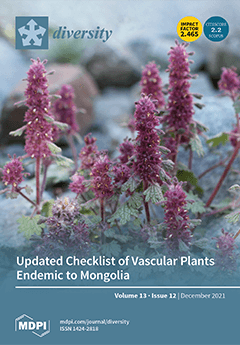The simple thalloid liverwort
Apopellia endiviifolia is a widespread Holarctic species belonging to the family Pelliaceae. European populations of this species comprise two distinct evolutionary lineages named “species A”, known also as water form, and typical, mainly terrestrial forms named “species B”. Newly
[...] Read more.
The simple thalloid liverwort
Apopellia endiviifolia is a widespread Holarctic species belonging to the family Pelliaceae. European populations of this species comprise two distinct evolutionary lineages named “species A”, known also as water form, and typical, mainly terrestrial forms named “species B”. Newly sequenced, assembled and annotated chloroplast genomes of six European specimens belonging to the two cryptic lineages occupying different microhabitats, revealed the structure typical for liverworts and previously sequenced reference. The plastomes of
A. endiviifolia are 120,537–120,947 bp long with a structure typical for most plants, including a pair of IR regions (each of 9,092–9,207 bp) separated by LSC (82,506–82,609 bp) and SSC (19,854–19,924 bp) regions and consist of 121 unique genes, including 81 protein-coding genes, 6 genes of unknown function (
ycf genes), 4 ribosomal RNAs and 30 transfer RNAs. Comparative analysis of typical, terrestrial and water forms revealed 4971 molecular diagnostic characters (MDCs), which exceeds numbers found in many well recognized liverworts taxa. Moreover, beside the presence of evolutionary hotspots like
ycf1 and
ycf2 genes and several intergenic spacer like
ndhB
-psbM,
rps4
-ndhJ and
ndhC
-atpE, the molecular identification of
Apopellia cryptic species was possible by almost 98% of 500 bp long frames simulating mini barcodes. The different ecological niches can be driven by different pressures of positive selection, which was detected in nine genes including
ccsA,
ndhD,
ndhF,
petA,
psbB,
psbC,
rpoB,
ycf1 and
ycf2. Despite clearly genetic differences and ecological preferences, the current observation of morphological differentiation does not no allow to separate terrestrial and water forms into taxonomic species.
Full article





